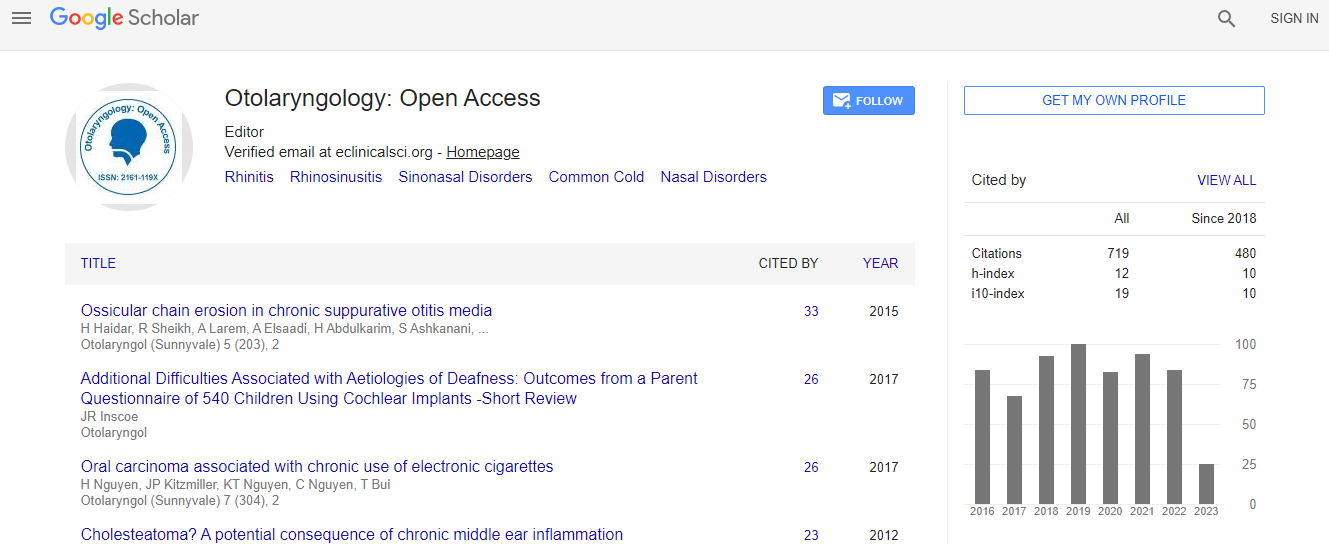Our Group organises 3000+ Global Conferenceseries Events every year across USA, Europe & Asia with support from 1000 more scientific Societies and Publishes 700+ Open Access Journals which contains over 50000 eminent personalities, reputed scientists as editorial board members.
Open Access Journals gaining more Readers and Citations
700 Journals and 15,000,000 Readers Each Journal is getting 25,000+ Readers
Google Scholar citation report
Citations : 925
Otolaryngology: Open Access received 925 citations as per Google Scholar report
Otolaryngology: Open Access peer review process verified at publons
Indexed In
- Index Copernicus
- Google Scholar
- Sherpa Romeo
- Open J Gate
- Genamics JournalSeek
- RefSeek
- Hamdard University
- EBSCO A-Z
- OCLC- WorldCat
- Publons
- Geneva Foundation for Medical Education and Research
- ICMJE
Useful Links
Recommended Journals
Related Subjects
Share This Page
ENT endoscopic tests optimization taking into account patient features
3rd International Conference and Exhibition on Rhinology & Otology
Amaia Mendez Zorrilla, Garcia-Zapirain B, Oleagordia-Ruiz I, Perez-Izquierdo A and Santaolalla F
University of Deusto, Spain
ScientificTracks Abstracts: Otolaryngology
Abstract
Hypothesis: Personalizing the material used for the tests based on the physiological characteristics of each patient can reduce patient discomfort during endoscopies. Background: It is common to use similar probes in terms of diameter and length regardless of the characteristics of the patient. This can cause discomfort during execution of the tests and can lead to results of worse quality than expected. Methods: A low-cost app installed on an iPad which from a photo of the patient performed at a set distance can extract the necessary measurements for the probe could optimize endoscopies. The application includes an algorithm that automatically calculates distances including bends that the fiber optic probe/strobe would go, so the doctor can prepare material for use with a personalized size for each patient. Results: We have performed simulations in the University of Deusto Evida Laboratory of patients with varied characteristics of age, race and skin tone. Tests have also included patients with different aesthetic characteristics such as beards, glasses or fringes. In 80% of cases the results are satisfactory in the first iteration. In 12.3% of cases the application does not detect the important points for calculations in the first iteration and needs a second, obtaining the expected results in the second attempt. Only in 7.7% of cases the app does not work properly at all, although the authors have found that the capture stage did not meet the 100% ideal lighting conditions and distance to the camera. Conclusions: ICTs are a great support to medical personnel and can improve the user experience during the clinical trials.Biography
Amaia Méndez Zorrilla holds a BSc in Telecommunication Engineering and a PhD in Computer Science from the University of Deusto. She is currently a lecturer at the University of Deusto, where she teaches at the Bilbao campus. She teaches BSc courses in Industrial Technology Engineering. Specifically, she teaches the following subjects: Networks I, TV and Video Digital Systems and Multimedia Networks. Her publications mainly focus on biomedical engineering and new technologies applied to society. During the past few years she has carried out research on the design and development of digital image-processing algorithms and on projects to improve the quality of life of people with special needs. She is part of the DeustoTech Life research team.
Email: amaia.mendez@deusto.es

 Spanish
Spanish  Chinese
Chinese  Russian
Russian  German
German  French
French  Japanese
Japanese  Portuguese
Portuguese  Hindi
Hindi 
